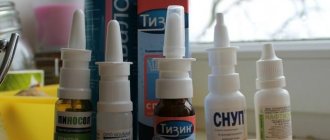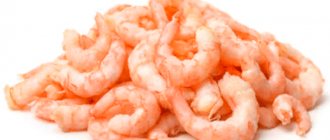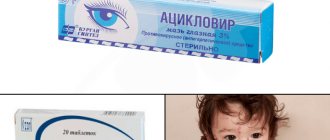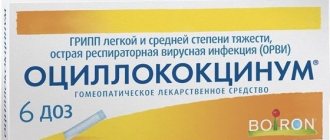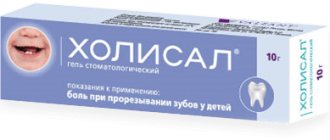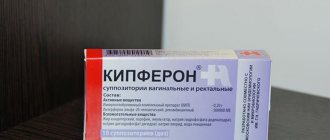Release form
Miramistin is produced only in liquid form. This solution does not have any taste or odor. It is completely transparent, but foams actively when shaken. The drug is available in several packaging options that differ in volume. On sale you can find bottles with a capacity of 50 to 500 ml.
In addition to volume, they also differ in attachments - some bottles are equipped with spraying devices, while others are equipped with special attachments for the treatment of urological or gynecological diseases. To treat a runny nose, Miramistin is usually used in 50 ml plastic bottles, which are accompanied by both a urological nozzle and a spray nozzle. You can also drip the drug into your nose, packaged in 150 ml flat or round bottles.
This packaging has a spray nozzle, thanks to which the medicine can be sprayed into the throat, but it can be easily removed.
Is it possible to rinse a child’s nose with a runny nose with Miramistin?
Miramistin is considered a modern antiseptic . It is indispensable for a runny nose and sore throat.
The good thing about the drug is that it is not absorbed into the blood through the mucous membrane.
This makes it safe to use. When asked whether it is possible to rinse children’s noses with Miramistin, otorhinolaryngologists give a positive answer. The drug is widely used in pediatrics and is even used for infants.
Composition and indications for use
Miramistin contains the active ingredient benzyldimethyl myristoylamino propyl ammonium chloride, as well as purified water. This substance is destructive for bacteria and microorganisms such as staphylococci, streptococci, and various types of fungi.
The drug has neither odor nor taste, so it is well tolerated by children of any age.
Miramistin is sold in pharmacies as an ointment, a solution in bottles of various sizes, or as a spray with a special nozzle convenient for rinsing.
The drug is used for the following diseases in children:
- Rhinitis of various origins;
- Inflammatory processes in the adenoids;
- Laryngitis – inflammation of the larynx;
- Sinusitis – inflammation of the paranasal sinuses;
- Sinusitis - damage to the maxillary sinuses;
- Frontitis - damage to the frontal sinuses;
- Tonsillitis – inflammation of the tonsils;
- Otitis is a disease of the middle ear.
The instructions for use contain a warning that before starting to use the drug in children, it is recommended to do a preliminary test to determine its tolerance.
If an allergic reaction occurs, Miramistin should not be used.
The price of the drug for 100 ml is about 250 rubles.
Methods of application
Each age category of children has its own characteristics when using the drug. For laryngitis, the baby instills medicine into the throat using a pipette.
To remove snot, the nasal passages are treated with a cotton swab dipped in a solution.
Miramistin should be used as drops for children against a runny nose, observing the dosage according to age:
- At the age of 1 year - 1 drop in each nasal passage;
- At 2 years - 2 drops;
- For older ages, drop up to 4 drops into the nose.
For older children, the product is used in the form of a spray. Miramistin should not be sprayed more than 3 times a day. The course of treatment is 10 days.
Also, washing the nasal sinuses for green snot in a child is considered quite effective, which should only be done if prescribed by a doctor. Moreover, this procedure is prohibited for children under 2 years of age.
Washing is carried out with a diluted preparation consisting of saline and Miramistin in a ratio of 2:1. It is important to explain to your child how to properly rinse his nose.
You need to bend over the sink and use a special nozzle to inject the drug into one nostril under pressure. In this case, it is forbidden to suck in the liquid through the nose; it must exit through the other nasal passage.
Then you need to blow your nose out of the remaining medicine. Repeat the procedure for the second nostril. After rinsing, Miramistin should be dropped into the child’s nose. The course is carried out until clear nasal discharge appears.
Miramistin is also used as a gargle for inflammatory processes in the throat .
The drug should not be used for nasal congestion.
But as a prophylaxis against ARVI, the medicine gives good results. But it is worth remembering that with prolonged use, children become addicted to Miramistin.
Analogues of Miramistin
This drug has the following analogues:
- Chlorhexidine is used only in hospital settings for rinsing the nose of children.
- Dioxidin is used for purulent-inflammatory diseases. The drug has vasoconstrictor and antihistamine properties. Therefore, when choosing a product between Miramistin or Dioxidin, you should give preference to the latter.
- Okomistin helps treat not only rhinitis, but also eye inflammation.
Chlorhexidine Dioxidin Okomistin
Before using any medicine, you should consult a doctor. Especially when it comes to treating young patients.
Miramistin is usually prescribed to children as a remedy that should be instilled for a runny nose. It is necessary to drip the medicine in the dosage prescribed by the attending doctor.
It is also used for gargling and nasal rinsing. The use of Miramistin for infants should be strictly under the supervision of a physician.
Reviews
Natalya, 30 years old
Our son started going to kindergarten, and a runny nose became commonplace for us. The doctor advised taking one drop of Miramistin before visiting the garden. It cannot be said that this protected us completely from illness, but runny noses began to appear less frequently.
Victoria, 27 years old
My daughter returned from kindergarten with a high temperature. The throat was sore and red. The doctor advised spraying the throat with Miramistin 3-4 times a day. I did not prescribe antibiotics. After 3 days the temperature subsided. We didn't accept anything else. Miramistin cured us.
Larisa, 34 years old
I have two children - 10 years old and 2 years old. Miramistin is always in my medicine cabinet. When my little one has a cold, I drop medicine into his nose; the older one rinses his nose when he has a runny nose. I am very pleased with this product.
Source: https://pnevmonii.net/preparaty/miramistin
At what age is it allowed?
The instructions for the solution include information that its use is possible from the age of 3, but doctors classify Miramistin as a safe topical agent, so they prescribe it at an earlier age (sometimes even to an infant). However, it is not recommended to bury the nose of both a child under three years old and a 3-year-old toddler or older without the consent of a doctor.
Only a doctor can determine whether the baby needs an antiseptic or whether other medications are required.
Miramistin in the nose of a child with a runny nose, important rules
Miramistin is usually prescribed to children as part of a complex treatment. The drug is produced in the form of a nasal spray, which has a local antiseptic effect. It is also worth remembering that a runny nose is just a symptom of a respiratory disease, so Miramistin is used only as an adjuvant in combination with other medications.
Why choose to treat a runny nose?
This remedy will be useful if the child has a bacterial infection. But ARVI or allergic reactions are best eliminated with vasoconstrictor drops.
Miramistin cannot penetrate deep into tissues and eliminate the infectious process developing there. However, the advantage of this antiseptic is that it is not absorbed into the bloodstream, which means it is an absolutely safe remedy for the common cold. But at the same time, the effectiveness of the drug is not as high as we would like.
The drug also does not have a symptomatic effect; it does not make breathing easier and does not relieve swelling of the nasal mucosa. But the spray has a local antiseptic effect for sinusitis, pharyngitis or tonsillitis, that is, those diseases in which microbial infections develop.
In this case, the drug must be used correctly and as prescribed by a doctor.
Is it possible to rinse a child’s nose with Miramistin?
The instructions for the drug do not indicate the possibility of rinsing the nose of children with a spray. In addition, parents should know that if the child does not improve within a week of using Miramistin, they should inform the doctor and reconsider the appropriateness of the prescribed remedy.
As for rinsing the nose with the product, indeed, sometimes this method is used if the following diagnoses are present:
- Sinusitis in acute or chronic stages.
- The presence of an infectious process that causes a runny nose.
Washing can be done for children from the age of five. Children under 5 years of age may swallow the liquid through saliva.
The procedure is not pleasant, although the substance does not have any taste, but during rinsing the child may experience itching and burning.
Is it possible to drip Miramistin into a child’s nose?
Children can be treated for runny nose with Miramistin from the age of three. Nasal drops of this drug are suitable for infants, but the spray cannot be used.
Thus, it is permissible for newborns to drip Miramistin into the nose only one drop into each nostril during the day. But this is done only when the parents are sure that a runny nose was caused by a bacterial infection and is not a manifestation of the body’s adaptation to a new environment.
For older children, this dose is tripled.
Children over 7 years of age are recommended to inhale Miramistin using a nebulizer. To do this, you need to mix Miramistin and saline solution in equal proportions. The process of inhaling steam during inhalation lasts about 2-3 minutes.
Older children can use Miramistin in the form of nasopharyngeal irrigation. To do this, the drug in the form of a spray is used with two pumps up to 3-4 times a day.
Contraindications for use
If used correctly, the product has virtually no contraindications and does not cause adverse reactions. But if unpleasant sensations arise, then it is better to stop using Miramistin. Such reactions may manifest themselves as follows:
- The appearance of itching, tingling or burning.
- Redness in the area where the medication was applied.
- Dry mucous membranes.
If the symptoms are minor, then you can continue to use the drug; the only thing you need to do is, following Miramistin, drip a moisturizing saline solution into your nose, which will soothe the nasal mucosa and moisturize it.
However, there are still minor contraindications to the use of the drug. This:
- Woman's pregnancy.
- Child hypersensitivity.
- Individual intolerance to the components of the drug.
How does it work?
After contact with the mucous membrane of the nasopharynx, Miramistin acts primarily locally. This solution has a bactericidal effect against a fairly large number of harmful microorganisms - both aerobic and anaerobic. Among the bacteria sensitive to the drug are Escherichia coli, gonococcus, Klebsiella, Pseudomonas aeruginosa, pneumococcus, staphylococcus and other microbes.
Miramistin is capable of destroying both one type of microorganism and several pathogenic bacteria from which the association was formed. The medicine is also effective against those strains that have become resistant to the most commonly prescribed antibiotics (they are called hospital-acquired). The difference between Miramistin and antibacterial agents is its ability to destroy certain types of viruses, for example, herpes.
In addition, the solution also has an antifungal effect, so its use helps get rid of candida and some other fungi.
Why choose to treat a runny nose?
Instillation of Miramistin for rhinitis is in demand due to the following features of the drug:
- The solution has a very wide range of effects on many pathogenic microbes.
- Treatment with Miramistin makes pathogens more sensitive to the action of antibiotics.
- The drug effectively helps to get rid of not only bacteria, but also many viruses and fungi.
- The medicine also has an anti-inflammatory effect.
- The use of the solution activates local immunity factors.
- The medicine has no irritating effect on the nasal mucosa.
- The medication does not harm viable cells that are not affected by the infectious process.
- Treatment with the solution stimulates reparative processes.
- Miramistin is freely sold in most pharmacies as an over-the-counter product.
Indications
Miramistin is used for the following diseases of the nasopharynx:
- ARVI. If such an infection causes inflammation of the nasal mucosa, the solution helps eliminate viruses, reduce the activity of inflammation and prevent complications (for example, otitis media).
- Bacterial rhinitis. With such a runny nose caused by harmful microbes, Miramistin will directly affect the cause, which will speed up recovery.
- Sinusitis. For this disease, which is usually caused by bacteria, Miramistin is often used in combination with antibiotics.
- Adenoiditis. The use of Miramistin for adenoids helps reduce the inflammatory process and prevent complications.
In addition, the medicine is in demand for pharyngitis, flu, sore throat and laryngitis. It is also actively used by dentists, surgeons, traumatologists and doctors of other specialties, prescribing it for the treatment of stomatitis, burns, purulent wounds, diaper rash, thrush, urethritis and other problems.
Can the medicine be used by newborns and children under 1 year of age?
Having opened the instructions and glanced at the section “In children”, we see that the manufacturer recommends using the drug for young patients from the age of three. But what if the doctor still prescribed the drug for the baby? The choice is up to mom. Miramistin is considered completely harmless, non-toxic, hypoallergenic. Moreover, the product is used by women in labor to disinfect the birth canal. This means that baby’s contact with the substance is absolutely safe. It is not absorbed through the mucous membranes into the blood, and therefore does not have a systemic effect.
But the main question in the use of Miramistin in infants is not whether it is harmful, but whether it will be beneficial.
It is worth repeating once again that this remedy is not a cure for the common cold. The manufacturer himself, interested in expanding the spectrum of action of his product, indicates that the drug is used in the nose only for sinusitis. Even the release form quite transparently hints to parents that the product is intended for external use (ointment and spray), vaginal procedures or rinsing. It can be argued that Miramistin is available in the form of drops. Yes, but only eye ones. They, of course, can be dropped into the nose, but if they were intended for this, the manufacturer would have written about this on all available spaces on the label.
Like any medicine, Miramistin in the nose should not be prescribed to children independently. But if this happens, use only drops to treat a runny nose. When you have the spray at hand, remove the nozzle and carry out the procedure with a pipette. A child's nose is small and the pressure of the substance released under pressure from the spray nozzle can push pathogenic microorganisms deeper into the nasal sinuses or even into the middle ear. By the way, pay attention to the width of the nozzle - it is clearly not intended for a small nose.
Contraindications
The solution should not be used in children who are intolerant to miramistin. There are no other contraindications to treatment with the medicine, because the second ingredient is only water, and the medicine does not enter the bloodstream, so it cannot harm the internal organs.
Contraindications and side effects
Returning to the history of the drug, we recall that one of the main requirements for the drug was its absolute safety. Over decades of use, manufacturers have never received data on any significant side effects. The drug is used in the treatment of various diseases, as well as in the postoperative period, when the body is weakened, and even on open wounds and burns, i.e. in direct contact with blood and affected tissues.
The only side effect the manufacturer notes is the possibility of a slight burning, itching or tingling sensation immediately after applying the product. The discomfort lasts no more than 15 seconds and disappears on its own, without the need to take additional medications.
However, if after using Miramistin you notice atypical behavior in a child or other alarming symptoms, be sure to stop treatment with the drug and report your concerns to your pediatrician.
Miramistin is truly a unique, universal antiseptic. Mom should have it in her first aid kit in case of pharyngitis or sore throat, conjunctivitis, or stomatitis. A bottle of the drug is convenient to take on the road or for a walk in case of disinfection of wounds and burns. But treating a runny nose is a task for other means. Do not experiment on your own child, because the lack of adequate treatment with specialized drugs can cause complications or chronic rhinitis, which is difficult to treat.
Price and storage conditions
On average, you need to pay about 200-220 rubles for a 50 ml bottle, and a 150 ml bottle costs about 350 rubles. The shelf life of the solution is 3 years. Until it expires, you should keep the medication at home at room temperature, choosing a place hidden from children.
Reviews
You can see many positive reviews about the treatment of runny noses in children with Miramistin, in which parents note the high effectiveness of the antiseptic. The medication is praised for its ability to treat even small children and the absence of an unpleasant aftertaste. Mothers confirm that the treatment is generally well tolerated, and an allergic reaction to the solution occurs in isolated cases.
In the negative reviews that are sometimes found, you can read about the lack of therapeutic effect (this is possible with an advanced disease) and the high price.
Composition and properties
Now we can imagine why Miramistin was created. But after a couple of decades, some pharmaceutical companies were able to buy the patent for the production of the drug. This is how the medicine became known to a wider audience. Now it is successfully used in gynecology and surgery, dentistry and traumatology. Miramistin also found itself in ophthalmology, but more on that separately.
Over the decades, the miracle remedy has shown its effectiveness against many types of bacteria and fungi, including “armored” hospital strains.
The developers say that the solution has some effect on viruses, in particular herpes and HIV.
How does Miramistin compare favorably with most modern medicines?
- The inability to be absorbed through the skin and mucous membranes is a quality that is extremely important for pregnant women and small children. This means that the medicine does not enter the bloodstream.
- The drug does not provoke allergic reactions.
- Over the almost 50-year history of use, no side effects have been noticed with Miramistin.
Thus, Miramistin is a universal antibacterial agent approved for use by all categories of patients without exception. Even individual intolerance to the components of the drug is an extremely rare case, due to the fact that there is only one active ingredient and it is hypoallergenic.
Miramistin is produced in the form of a solution or a more concentrated ointment. It can be purchased as liquid in bottles of different sizes. They are equipped with a spray nozzle or a urological applicator.
Analogs
The following antiseptics can replace Miramistin in the treatment of a runny nose:
- Cameton. This medicine based on menthol, eucalyptus oil, chlorobutanol and camphor destroys harmful bacteria, reduces inflammation and nasal congestion. An aerosol is prescribed from the age of 5, and a spray from the age of 7.
- Protargol. These drops act thanks to silver proteinate, destroying pathogenic microbes. The medication is used from birth, because it has only a local effect.
- Dioxidine. Such a solution with antimicrobial activity can be dripped into the nose only after a doctor’s prescription. It is often prescribed for prolonged runny nose and is included in “complex” drops, combined with other medications.
In addition, in the treatment of rhinitis, instead of Miramistin or together with it, sea water preparations, oil drops, immunomodulating drugs in the nose, antibacterial drops, vasoconstrictor drugs and homeopathic remedies can be used. All of them act on the child’s body differently, so it is not advisable to take any of the medications from these groups without consulting a doctor.
A dermatovenerologist tells everything about this drug and its use not only in children in our next video.
Is it possible to rinse a child’s nose with Miramistin?
A constant companion to colds in children is a runny nose, medically called rhinitis. This pathological process in most cases acts as a symptom of various diseases and can have a different nature of manifestation. An independent disease, a runny nose can appear only in every fourth case.
Most parents opt for popular treatment methods, including Miramistin for the common cold. Many pediatricians recommend this drug for children, excluding treatment with more serious medications. But is such treatment justified?
Composition and pharmacological action
Before asking the question: is it possible to rinse a child’s nose with Miramistin, first you need to understand what the drug is and what effect it has on the child’s body.
The medical product is produced in different forms - a solution for topical use with a concentration of the active substance of 0.01%, a spray with an additional anatomical nozzle and an ointment .
The composition of the medical product includes the active component benzyldimethyl-myristoilamine-propylammonium chloride monohydrate and auxiliary components in the form of water-soluble substances.
Due to the low concentration of the active substance, Miramistin is
absolutely safe for the treatment of inflammatory processes of the nasal mucosa, while being quite effective against most pathogens.
The powerful antiseptic has no odor or taste, has hypoallergenic properties and has no contraindications, so it can be easily used to treat children.
In complex treatment with antibiotics, there is a decrease in the resistance of pathogens to bactericidal drugs. When using Miramistin externally and locally, systemic absorption (absorption) of the active substance into the systemic bloodstream is excluded.
Important! At the site of application of the drug, minor irritation in the form of a burning sensation may occur, which goes away on its own within 20 seconds. This manifestation is not an indication to stop using the medication.
The antibacterial, antiviral effect of the drug helps cleanse the mucous membrane of pathogenic microorganisms and their waste products, prevents the formation of purulent exudate, which allows the use of Miramistin for green snot in a child, as well as for therapy:
The action of Miramistin is to some extent similar to the action of drugs with a vasoconstrictor effect, only in this case the antiseptic does not affect the blood vessels , but only helps to dry out the mucous membrane.
The medication can be used both in the complex treatment of ENT organs and as preventive measures. But it is worth understanding that long-term use of Miramistin can cause addiction and provoke resistance of pathogenic microorganisms to the drug.
Procedure for rinsing the nose of children with Miramistin
Treatment of diseases with an antibacterial drug requires strict instructions from the attending physician, who will explain how to rinse the child’s nose with Miramistin, what dosage to follow and how long the course of therapy should last.
In practice, most specialists choose Miramistin as a milder replacement for vasoconstrictor drugs. The instructions for use in the nose for children do not contain information about the use of this product in the form of rinsing, but if this medical product was prescribed, but did not bring a visible effect within seven days, the treatment requires adjustment.
It is worth noting that the absence of indications for rinsing in the annotation does not prohibit the use of the drug to cleanse the nose, since Miramistin is a safe product .
The desired result during treatment is achieved with strict adherence to the number and frequency of washings. For infants, the drug is not recommended for use, due to the inability of the child to independently cough up or blow his nose, which can provoke an increased concentration of the substance in the nasal cavity or internal organs.
Therefore, to avoid the drug getting into the tympanopharyngeal tubes and respiratory organs, Miramistin is prescribed to children only when they reach the age of three .
You can find out how to recognize a physiological runny nose in a baby here.
If the treating specialist, after weighing all the pros and cons, prescribes Miramistin for the treatment of runny nose for
children under 12 months , you must adhere to the following recommendations:
- Use exclusively drops that are introduced into the nasal passage with a sterile pipette, no more than 1 drop 3 times a day .
- Each rinsing procedure must be preceded by a procedure for cleansing the nasal passages using an aspirator.
- Dilute Miramistin with saline solution in a 1:1 ratio .
Children from 3 to 12 years old can use one of the spray, no more than 3 times a day .
Patients over 12 years of age may be prescribed nasal rinsing with the drug diluted with saline in a ratio of 1:2 . Irrigation of the nasal cavity is carried out three times a day 3 ml is used for one procedure diluted solution . The duration of therapy is no more than six days .
Important! The drug has no contraindications or side effects. An exception may be individual intolerance to the component. Therefore, when starting treatment with Miramistin, it is necessary to monitor the child’s reaction.
Recommendations of Dr. Komarovsky
Most parents try to adhere to the treatment recommendations of a well-known pediatrician. What is the doctor’s opinion about “Miramistin” in a child’s nose? Komarovsky does not recommend using this drug without the instructions of the treating pediatrician.
Especially for patients under three years of age , since prescribing this medical product before reaching the specified age is considered a violation of medical regulations.
Moreover, Dr. Komarovsky adheres to a complete refusal of medicinal products when treating runny nose in children, with the exception of some cases. Indispensable manipulations, according to the famous pediatrician, are:
- maintaining humidity and appropriate temperature in the room;
- drinking plenty of water;
- rinsing the nose with saline solution, purchased at a pharmacy or prepared independently.
Therefore, each parent’s personal choice will be to adhere to Komarovsky’s recommendations or follow the instructions of the treating pediatrician.
"Miramistin" for children with a runny nose: reviews
Alina. After the child went to kindergarten, a runny nose became a constant illness for us.
No matter what we tried, we applied oxolinic ointment for prevention purposes, and bought vasoconstrictor drops, but a week later the runny nose recurred again.
The pediatrician recommended Miramistin spray; my daughter sprayed it on her nose with pleasure, since it has neither taste nor smell. For us personally, the product helps already on the second day - congestion subsides, the amount of snot decreases, and the child breathes through his nose.
Anna. We started treatment with Miramistin on the advice of my sister, after consulting with a pediatrician. The child's condition improved significantly after just four days. Since the doctor warned that the product could be addictive, we then switched to rinsing with saline solution.
Conclusion
To summarize, we can conclude that Miramistin is a fairly effective medicine and is well tolerated by both adults and children. But every parent should understand the dangers of self-medication, therefore the recommendation for the use of this medication should be prescribed by the attending physician.
Source: https://dety-zdorovy.ru/nos/mozhno-li-miramistinom-promyvat-nos-rebenku
Nasal rinsing with Miramistin: how to properly rinse your nose for congestion
Miramistin is considered a good antiseptic, which is popular among the population and is used to treat diseases of the nasal cavity.
According to reviews from patients who have used this drug, the solution eliminates the causes of a runny nose within a few days. It is actively used in the treatment of nasal congestion in children.
It is worth paying attention that before use you need to familiarize yourself with the composition, features and possible side effects.
Miramistin has established itself as a universal remedy in the treatment of ENT diseases, surgery, and gynecology. It is widely used in therapy, since it has virtually no contraindications for use and is not limited to any area of application.
Description of the drug
This medical product has long established itself as a good antiseptic and anti-inflammatory product. It is used not only for therapeutic purposes, but also for preventive measures.
Read the link to learn how to use Aqualor.
Key indications for the use of Miramistin include:
- Pathologies of the inner and middle ear, treatment of otitis of varying severity.
- Sinusitis, sinusitis, sinusitis. Thanks to the active substance in the composition of the product, it has a beneficial effect on eliminating signs of a runny nose; it is used to rinse the nasopharynx and as drops. If there is sinusitis of an allergic nature, then the use of a pharmacological product reduces swelling of the nasal mucosa and restores breathing. In the treatment of sinusitis and frontal sinusitis, the drug is administered by puncture.
- Problems associated with diseases of the larynx and pharynx (tonsillitis, pharyngitis, laryngitis).
In general, the effect of this drug appears a few days after regular use.
Read how to use Aquamaris here.
Self-medication is dangerous! Therefore, to prevent possible complications, before using Miramistin, you should seek advice from a specialist.
pharmachologic effect
The effect of Miramistin on the human body is varied. It is used in otolaryngology, surgery, gynecology, the drug has a complex effect, its effectiveness has been clinically proven.
Source: https://dou99.ru/nos/mozhno-li-miramistinom-promyvat-nos-rebenku


